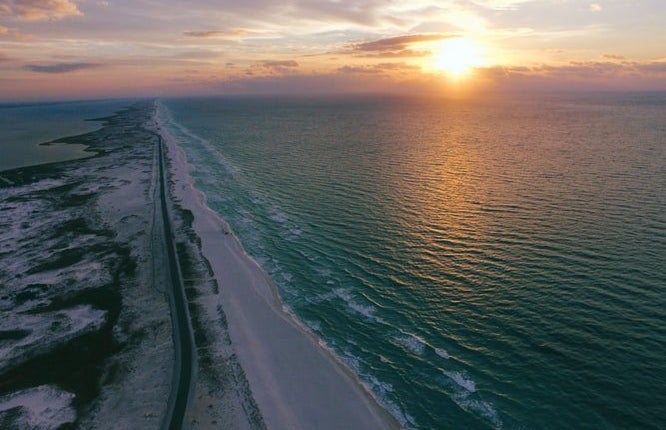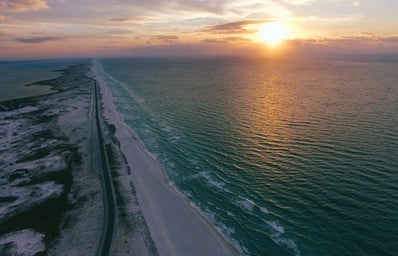This past weekend, in an attempt to curb the stress of my looming exams, I watched all three of the original Pirates of the Caribbean movies in an 11 p.m.-to-6 a.m. marathon Friday night. It had been some time since I had seen these films, and I was astonished by the artistry of the storytelling, the sets, the score; all of which had been lost on me when I was a child, jaded by a distaste for sincerity in film.
When did that happen? When did we, as a society, decide we were too good for stories unapologetic in their themes of love, adventure, and courage? But the honest truth is, we crave these stories, even though we might be loathe to admit it. We want to stand with Elizabeth in her fearlessness, her passion, when she is rallying the crew from the railing of the Black Pearl. We want to yearn with Will as he pines for a woman he believes he has no chance with. And, of course, we want to watch in awe with the rest of the crew as Jack Sparrow figures his way out of yet another inescapable situation.
It is not uncommon to connect with stories this way. We’ve been doing it since we had the tools to write things down in the first place. An epic is especially good at mirroring our world, and this quality is perhaps what has made it one of the most revered and enduring forms of literature in our history, spanning the entirety of human civilization. Because it is a distinctive form of literature, the Epic is set apart from others by several key features.
My thesis is simple and my course is clear. The trilogy displays many, if not all, of these key features, and is therefore an Epic itself. Here’s why:
- Epics start in the middle (in media res), with the protagonist at a low point
-
The first time we meet the famous Captain Jack Sparrow, he’s just been marooned on an island alone, with a gun with a single bullet, right after he was mutinied by his crew and robbed of the ship he loves more than anything in the world. I’ll say that’s a pretty solid rock bottom. We, as the audience, are not made aware of any of this until later in the narrative.
Also, before we get to the opening of the film, several events have already taken place that are essential to the actual plot of the film. Jack’s been mutinied, obviously, but Barbossa and the remaining crew have already gone to the Isle De Muerta to find the treasure and they’ve already spent it. Will’s father, Bootstrap Bill Turner, has already been killed and taken into the service of Davy Jones, and Will has already been cut off from his family history. All of these events occur too close to the start of the movie, involve too many characters, and are too heavily involved in the plot to be simply backstory. We are starting in the middle, and we are starting from the bottom.
- Epics involve a setting that spans as much of the world as possible
-
The reach of these films in terms of geographic setting is unbelievable. While the first film tended to be limited to just around in the Caribbean, it is in the latter two films that we get to see more of the world. References are made to discovery in the “new world” by the EIC in a flippant sort of way, but where the setting shines is through the characters, who come from Africa, the Middle East, Europe, the Americas, and Southern and Eastern Europe. The main characters travel most notably to Singapore, which is almost literally half a world away from the Caribbean, and is an even longer journey by sea that would have taken the characters through the Americas and the entire Pacific Ocean. There are even trips beyond this world into the afterlife (which we will be discussing later). There is no stone unturned in the broad setting of Pirates of the Caribbean.
- Epics are highly stylized
-
Do I need to elaborate? I’m going to elaborate.
So in terms of setting at a small scale, the detailed dressing of the settings are nothing short of fantastic in every circumstance, walking beautifully the line between gorgeous and gaudy. It reaches the limit without falling over.
However, the stylization is not limited to just the sets. Turn to the score, which so flawlessly invokes the spirit of adventure and freedom that the pirates seek. Turn to the costumes, which are historically accurate (the exception being the whole forest business, but I digress) but also serve a symbolic purpose, as what a character is forced to wear versus what they choose to wear so often mirrors their character development.
The artistic department on these films was given a mission and just went for it in every aspect of design. The end result is a product that is stylized to perfection visually but grounds itself through its characters.
- Divine Intervention
-
The sea is treated as a deity in its own right, and is personified in the trapped goddess Calypso and her estranged lover Davy Jones. Their mythic love story is what drives the plot of the latter two films. Also, the legendary beast, the Kraken, is a part of the story too, wreaking havoc on unsuspecting ships just as humans once believed it would if you sailed just a bit too far off the map. Deities commonly walk among people, as people, and have varying degrees of power in the POTCCU (Pirates of the Caribbean Cinematic Universe).
- Based (loosely) on history
-
Pirates of the Caribbean is actually a lot more historically accurate than you would think. Not in terms of like, curses and stuff, but pirates in history were actually a pretty diverse bunch, and it was not uncommon for women to be captains or commodores of pirate fleets. In fact, one of the most famous pirates in history was an Asian woman. The Pirate Lords of the Brethren Court and their crews mirror this fact. Even Jack’s own crew on the Black Pearl was diverse in terms of race, gender, and ability, all of which would be historically correct.
The “Loosely” part comes, of course, from the fact that there were no real monsters, no curse, no sea gods, but there was a time when we as humans believed sincerely in these things, and feared them. And even things that aren’t real have the power to shape us if we believe in them this way. So a story based on a myth that we treated as fact is a story based on our history.
- Katabasis, Baby
-
There is a Katabasis—a trip to the underworld—in Pirates of the Caribbean: At World’s End. The crew of The Black Pearl goes to Davy Jones’s Locker to retrieve Jack from the dead. This happens, the characters interact with other souls in the Underworld and get a sense of how it works, and how travel between the worlds is made possible through the Up is Down sequence.
- Ekphrasis, Baby
-
Ekphrasis is the description of some object that serves a learning purpose. We have two instances of this in Pirates of the Caribbean.
The first is Jack’s compass that points to whatever he wants most. This object teaches us that it is important to know our intentions, because not everyone does. It teaches us that a person with direction but no drive is as bad as a person with neither. It is highly sought after in the narrative for this reason.
The second is Davy Jones’s heart. This object has a lot to do with destiny, but more to do with trust and doubt. Where Davy Jones fails, Will is able to succeed. Davy Jones hides his heart away from those he loves, isolates himself, and does not rise to his post, and for that he suffers. Will gives his heart to his wife in an act of love and trust, and it is suggested in the narrative that he has a better time with the whole ferrying souls to the underworld and keeping watch over the seas thing than his predecessor. It shows us that when we isolate ourselves at our lowest point, things will only get worse, and that trust is what makes relationships last.
- Epics evoke nostalgia
-
So, why does a movie based in a time period that none of us lived in and that honestly wasn’t that great invoke such nostalgia? Because you can’t just get on a boat and sail away from your problems now. You have to pay your taxes. No matter where you go someone is going to hunt you down and make you pay your taxes. Even though none of us have lived in a world where something like sailing off into the sunset because you don’t want to work for a corporation is a thing you can do, we still dream about doing it and we are eager to consume media that tells us that once upon a time, that might have been possible.
- Repetition and Callbacks
-
Callbacks and repetitive speech in an ancient epic were often the result of stories being compiled after they were passed down through an oral tradition, but since then they’ve become a key element of the literary form. The most obvious is “why is all the rum gone,” but we also have the references to Jack’s brand, “You will always remember this as the day…,” the monkey that keeps popping up, “it never would have worked out between us,” and much more. This is called an epithet and is featured heavily throughout the films.
- Epics tell us about ourselves
-
This is the final and most important characteristic that I am going to analyze, because this is the single most defining feature of every epic that has endured to the modern day.
Stories like Pirates of the Caribbean speak not just to who we are, but who we want to be. They teach us about ourselves in a way that the real world doesn’t. Take, for example, the East India Trading Company, one of the villains of Dead Man’s Chest and At World’s End. In the real world, a major corporation with a hold on markets all over the world is seen as the peak of human progress, a type of personal success that we should strive to be a part of and be complicit in. But stories show businesses like this for what they really are: unfettered strongholds of power, driven by greed and hubris, willing and happy to exploit whatever and whoever necessary to make even just one extra dollar.
The humanity in these films is afforded to those on the bottom, those being exploited or controlled by the ruling class. Even characters who do not feature prominently in the narrative overall give us this moral lesson—that freedom is more valuable than wealth, that courage is more important than security, that complacency is only ever a form of cowardice. Take the hanging scene at the beginning of At World’s End. One moment of unity is enough to make the folks at the EIC falter. And the song featured here, Hoist the Colors, is mirrored in the speech by Pirate King Elizabeth Swann as she speaks for those who were silenced, as they move to take on the EIC and their supernatural allies.
What defines us, these films say, is our desire for freedom, our love of the world and its vastness, and the communities we build for ourselves when it feels like there’s no where else we belong. We are made to explore and discover. We are brave, passionate, and even if we don’t always know exactly what’s going on around us, we have the tools and the skills to figure it out and carve out a place for ourselves in the world. Our differences make us stronger and are often outnumbered by what we have in common.
In conclusion, Pirates of the Caribbean is an epic and honestly just a fantastic series. If nothing else, I hope I’ve inspired you to rewatch them. Make a day of it, get some snacks, and appreciate the fact that this trilogy is literally a modern example of the epic in cinematic form. Also, appreciate the score, Klaus Bedalt and Hans Zimmer really Did That.


